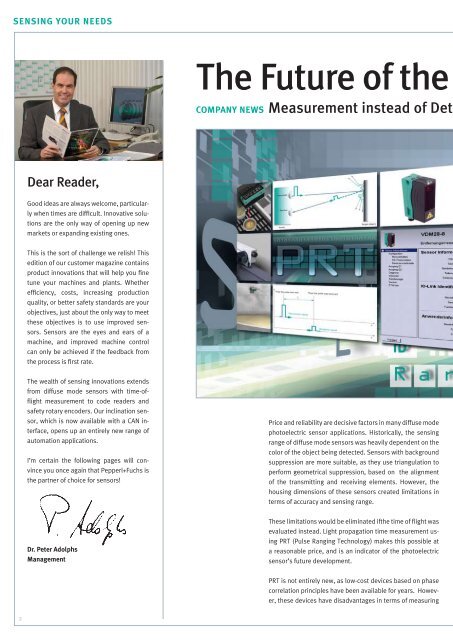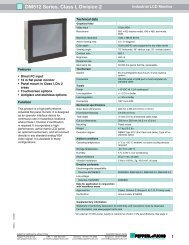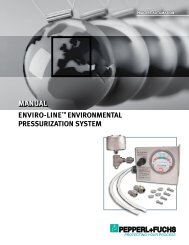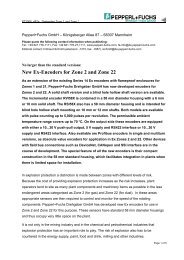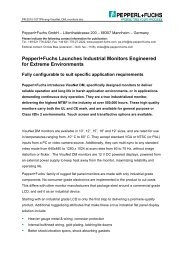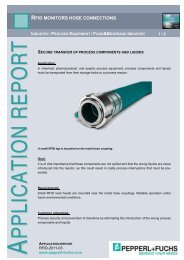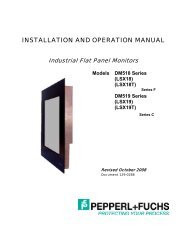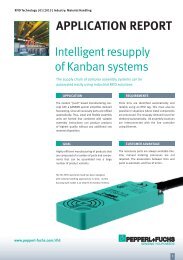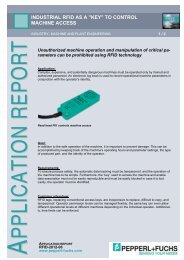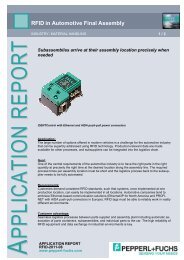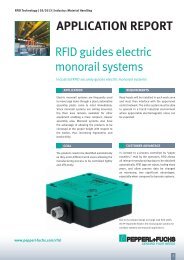SENSING YOUR NEEDS 02/2009 - Pepperl+Fuchs
SENSING YOUR NEEDS 02/2009 - Pepperl+Fuchs
SENSING YOUR NEEDS 02/2009 - Pepperl+Fuchs
You also want an ePaper? Increase the reach of your titles
YUMPU automatically turns print PDFs into web optimized ePapers that Google loves.
<strong>SENSING</strong> <strong>YOUR</strong> <strong>NEEDS</strong><br />
The Future of the<br />
COMPANY News<br />
Measurement instead of Det<br />
Dear Reader,<br />
Good ideas are always welcome, particularly<br />
when times are difficult. Innovative solutions<br />
are the only way of opening up new<br />
markets or expanding existing ones.<br />
This is the sort of challenge we relish! This<br />
edition of our customer magazine contains<br />
product innovations that will help you fine<br />
tune your machines and plants. Whether<br />
efficiency, costs, increasing production<br />
quality, or better safety standards are your<br />
objectives, just about the only way to meet<br />
these objectives is to use improved sensors.<br />
Sensors are the eyes and ears of a<br />
machine, and improved machine control<br />
can only be achieved if the feedback from<br />
the process is first rate.<br />
The wealth of sensing innovations extends<br />
from diffuse mode sensors with time-offlight<br />
measurement to code readers and<br />
safety rotary encoders. Our inclination sensor,<br />
which is now available with a CAN interface,<br />
opens up an entirely new range of<br />
automation applications.<br />
I’m certain the following pages will convince<br />
you once again that <strong>Pepperl+Fuchs</strong> is<br />
the partner of choice for sensors!<br />
Price and reliability are decisive factors in many diffuse mode<br />
photoelectric sensor applications. Historically, the sensing<br />
range of diffuse mode sensors was heavily dependent on the<br />
color of the object being detected. Sensors with background<br />
suppression are more suitable, as they use triangulation to<br />
perform geometrical suppression, based on the alignment<br />
of the transmitting and receiving elements. However, the<br />
housing dimensions of these sensors created limitations in<br />
terms of accuracy and sensing range.<br />
Dr. Peter Adolphs<br />
Management<br />
These limitations would be eliminated ifthe time of flight was<br />
evaluated instead. Light propagation time measurement using<br />
PRT (Pulse Ranging Technology) makes this possible at<br />
a reasonable price, and is an indicator of the photoelectric<br />
sensor’s future development.<br />
PRT is not entirely new, as low-cost devices based on phase<br />
correlation principles have been available for years. However,<br />
these devices have disadvantages in terms of measuring<br />
2


